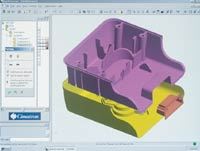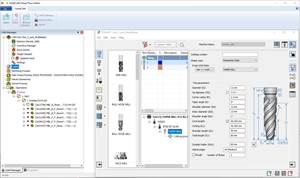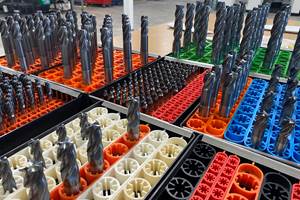Moldmaker Re-Engineers Tooling Process
Mold and die manufacturer LS Mold (Holland, Michigan) was looking to generate business growth by re-engineering its approach to tooling to secure a strategic advantage over its competition.
Mold and die manufacturer LS Mold (Holland, Michigan) was looking to generate business growth by re-engineering its approach to tooling to secure a strategic advantage over its competition. Central to this restructuring was an initiative to identify and streamline bottlenecks in the design-for-manufacture process. Family-owned LS Mold builds a wide spectrum of molds, ranging in size from very small to 1,000 tons and including plastic injection molds, aluminum die cast tooling, and form and trim dies. The company also performs basic machining services.
“Like most businesses, we’re trying to streamline how we do things and how we communicate,” says David Koning, LS Mold vice president. “Utilizing different software programs has been a tremendous help in not only speeding the pace of job flow through the shop, but also in improving the accuracy of the work. And, of course, that all starts with evaluating a customer’s data and developing a cost quote.”
LS Mold found in QuickConcept from Cimatron Technologies (Livonia, Michigan) the necessary catalyst for eliminating restrictive elements to achieve significant time and cost reductions and to develop a lean production process. With QuickConcept in its software arsenal, LS Mold’s CAD/CAM team enjoys quicker turnaround and accuracy in delivering part design, mold design, and manufacturing and reverse engineering services.
“We use QuickConcept in two of the most important initial stages of a project: data evaluation and quoting,” explains Mr. Koning. “When data arrive from a customer, we use QuickConcept to study it along the lines of product development to determine what is really going on with the part. Is the piece drafted correctly? Are there any noticeable slides and lifters? We examine it from a CAD point of view.
“Then, we use QuickConcept to look at the part from a cost estimating standpoint. We study the part along the lines of whether or not what we’re looking at is actually what the customer is asking us to quote,” says Mr. Koning. “We use the software to determine early on if there are problems with the CAD data. If there’s something we’re going to have to correct, we’re able to factor that into our bid from the onset.”
He says QuickConcept was instrumental in streamlining the tool development process because cost estimating specialists no longer had to rely on CAD engineers to gather information. Therefore, the teams didn’t have to operate on the same schedules. Each team member was able to perform an individual function at any time, and the information was presented in a format that all members of the team could understand.
The software also recently enabled LS Mold to deliver significant time and cost reductions when bringing a customer’s line to market. In a fraction of the time previously required, LS Mold performed meticulous data analysis, allowing it to identify flaws in the design data and recommend modifications early on to eliminate several time-intensive development stages and to develop accurate quotes that reflected the true cost of manufacture.
“When we have to deal with drawings, we invest 2, 3 or 4 hours in evaluating the data,” says Mr. Koning. “Using Quick Concept, performing quick part analysis now takes only minutes, versus hours. And, our quoting specialists can call the parts up on their own, without an engineer’s assistance, to determine the parameters of the project.”
QuickConcept transforms complex part CAD designs into easy-to-understand 3D models that can be analyzed, viewed and marked-up by anyone in the tool development process, from shop owners to cost estimators to tool designers¾even those who have never before sat in front of a CAD system.
“We don’t expect our cost estimating specialists to learn CAD material, because that’s not what they do day in and day out. But, using Quick Concept, they are able to extract the information they need in an easy-to-use format,” says Mr. Koning. “The program allows our quoting specialists to shade portions of the drawing and rotate the image to get a better feel for what they’re quoting. And now they can print directly from the program to get an even better handle on what they’re looking at.
“Having the ability to point out problems in very detailed design models more quickly and more accurately allows us to provide meaningful feedback in a timely manner to help spur a project’s success,” Mr. Koning concludes.
Related Content
When to Use Custom Macros With a CAM System
Custom macros can offer benefits even when using a CAM system to prepare programs – but must be implemented with the right considerations.
Read MoreBuilding A Powerful Bridge from the CAM Programmer to the Shop Floor Operator
SolidCAM for Operators provides a powerful bridge from CAM programming to the shop floor to best streamline the machine shop process with its CAM part simulation. It provides a clear picture to the operator for setup and prove-out, enables minor G-Code changes and avoids crashes, broken tools and scrapped parts.
Read MoreGrinding Simulation Enables Growth in Custom Tooling
Simulation software both streamlines Gorilla Mill's grinding machine setups and speeds up the company's tooling design and verification processes.
Read MoreIMTS Takeaways From the Modern Machine Shop Editorial Team
The first in-person IMTS in four years left the MMS editorial staff with a lot to digest. Here are a few of our takeaways from the show floor.
Read MoreRead Next
The Cut Scene: The Finer Details of Large-Format Machining
Small details and features can have an outsized impact on large parts, such as Barbco’s collapsible utility drill head.
Read More3 Mistakes That Cause CNC Programs to Fail
Despite enhancements to manufacturing technology, there are still issues today that can cause programs to fail. These failures can cause lost time, scrapped parts, damaged machines and even injured operators.
Read More
















.png;maxWidth=300;quality=90)

.png;maxWidth=300;quality=90)








